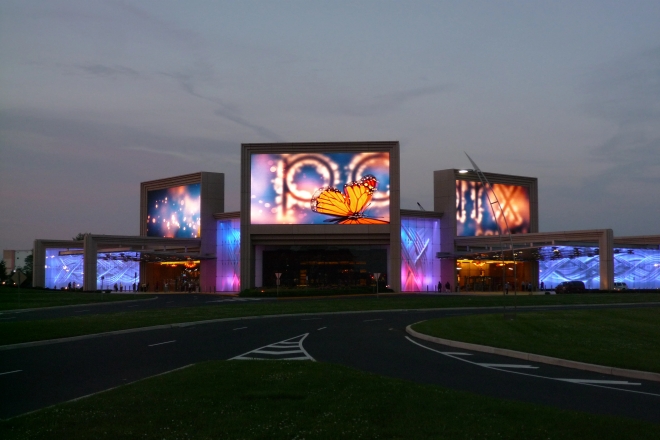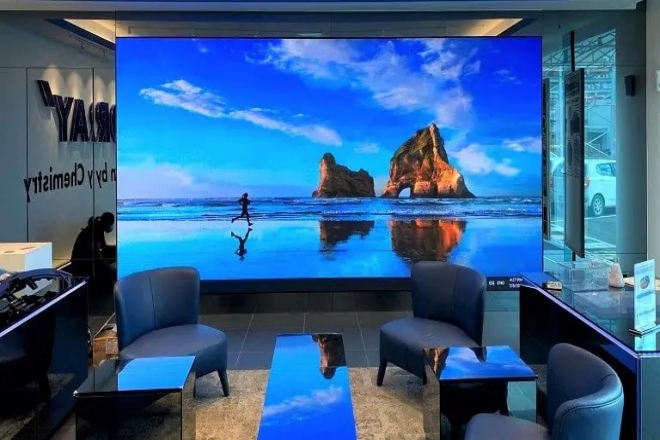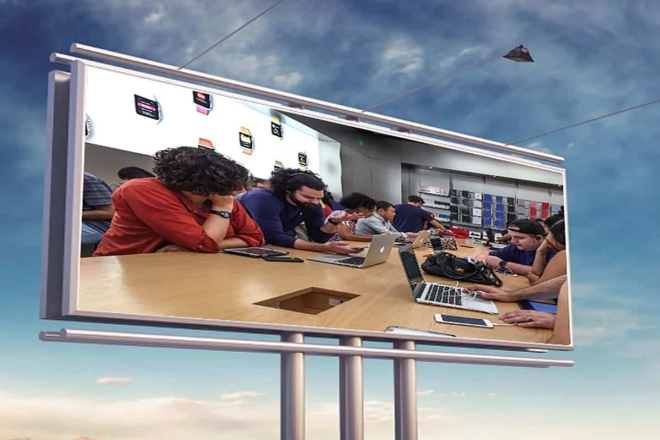介绍

你有没有站在令人眼花缭乱的 LED显示屏,犹豫不决不知道选择哪种尺寸才能完美满足你的需求?担心尺寸太大造成资源浪费,又担心尺寸太小影响观看体验?
在追求高效、完美的今天,选择合适的LED显示屏尺寸尤为重要。那么,如何在短时间内找到那个“黄金比例”,保证你的投资既经济又高效呢?
本文就带你直入主题,用三分钟掌握一套快速确定LED显示屏尺寸的方法,从明确使用场景到了解技术参数再到实际操作步骤和注意事项,一一为你揭秘。
1、明确LED显示屏的使用场景和需求
在选择LED显示屏之前,我们首先要弄清楚它要用在什么地方,要显示什么内容,这样才能选择最合适的屏幕。
1).使用环境:
室内还是室外:试想一下,如果你把一块屏放在商场里,环境相对稳定,光线也容易控制。但如果放在广场里,就得考虑风吹雨淋,白天的阳光会不会让屏看不清楚。
观众距离屏幕有多远:如果屏幕很大,但观众站得远,可能看起来不够清晰。因此,我们需要知道观众会站多远才能看到屏幕,以便我们选择合适的屏幕尺寸。
光照条件:如果屏幕放置在非常明亮的地方,例如户外或者非常明亮的房间里,屏幕就必须更亮一些,以便观众能够看得清楚。
2).内容要求:
显示什么:您要放文字、图片、视频还是直播?不同的内容对屏幕的要求不同。例如,播放视频可能需要更亮的屏幕颜色和更高的 解决.
对画质要求高吗?如果希望屏幕上的内容看起来非常清晰,像电影一样,就需要选择高清甚至超高清的屏幕。如果只是简单的文字或图片,要求就没那么高。
2、了解LED显示屏基本参数

当我们开始选择LED显示屏的时候,有几个关键参数是我们不能忽视的,它们就像是显示屏的“身份证”,告诉我们这块屏的性能和特点。
1). 分辨率和 像素间距:清晰度的秘密
分辨率,简单来说就是屏幕上像素的数量,决定了画面的清晰度,像素间距就是两个相邻像素之间的距离,距离越小,画面看起来就越细腻,细节也越丰富。
所以在选择的时候要根据观看距离来选择合适的分辨率和像素间距,如果距离太近,分辨率不够高,就可能出现“像素化”,画面看上去就像是由一个个小方块组成的。
2). 亮度 和对比度:色彩与层次的显示
亮度,以cd/m²表示,决定了屏幕在强光下的可视性。如果在户外使用,一定要选择高亮度的屏幕,这样白天才能看得清楚。对比度影响色彩的层次感和画面的立体感。对比度高的屏幕,色彩过渡更自然,画面更深邃。
3). 尺寸与比例:合适才是最好的
屏幕尺寸通常用“长×宽”来表示。选择时,除了考虑实际安装空间的大小,还要根据应用场景和内容布局来选择。
常见的屏幕比例有16:9、4:3等,它们各有特点,适用于不同的使用场景,比如16:9比例更适合观看视频,因为它更接近电影画面的长宽比,而4:3则更适合显示文档或图片。
同时还要考虑观众的观看舒适度,避免因屏幕过大或过小造成视觉疲劳。
3、LED显示屏快速计算选型
现在我们已经对LED显示屏有了足够的了解,是时候选择最合适的显示屏了。别担心,以下几个简单实用的步骤可以帮助您快速准确地做出选择。
1). 估计依据 观看距离
想象一下观众站在哪里观看您的屏幕。您可以使用一些简单的经验公式或在线工具。
只要输入观看距离,以及你想要的观看角度(比如你希望观众从任何角度都能看清楚屏幕),工具就会自动帮你估算出一个合适的屏幕尺寸范围,这样你就可以在范围内进一步选择。
2). 成本效益分析
买东西当然要考虑性价比了,选择LED显示屏不仅要看屏幕尺寸,还要考虑分辨率、亮度、色彩等因素对价格的影响。
你可以列出几种方案,比较它们的性能和价格,选择性价比最好的一种。
同时,还应该考虑未来可能出现的需求变化,比如是否需要预留一定的升级空间,以便将来可以更换性能更高的组件。
3). 现场测量与模拟
如果条件允许,最好现场测量一下安装空间的大小和形状,这样才能更准确的知道哪种屏幕尺寸合适。另外,还有很多虚拟软件可以帮助你模拟不同尺寸屏幕的安装效果。
您可以尝试使用该软件预览不同尺寸的屏幕在您的应用场景下的实际效果,这样您就可以更直观地感受到哪种尺寸最适合您的需求。
4. 注意事项

在选择LED显示屏的过程中,除了以上提到的重点之外,还有一些值得注意的地方,这些小细节都可能影响你后续的使用体验和维护成本,所以不容忽视。
1). 安装环境
承重能力:
LED显示屏安装前一定要确认安装位置的承重能力是否足够,大屏往往重量不轻,如果安装位置承重能力不够,可能会造成安全隐患。
通风散热:
LED显示屏在工作时会产生一定的热量,因此通风散热条件非常重要。如果安装环境封闭或通风不良,屏幕可能会过热,影响其使用寿命。
防水防尘:
对于户外或者特殊环境下的LED显示屏,防水防尘能力也是必不可少的,选择相应等级的产品,可以保证在恶劣的天气或者多尘的环境下,屏体依然能够稳定运行。
2). 售后服务
LED显示屏维护使用周期较长,因此售后服务尤为重要,选择售后服务体系良好的供应商,遇到问题能得到及时帮助,减少维护成本,确保无忧使用。
结论
选择合适的LED显示屏尺寸并不是一件简单的事情,需要我们综合考虑使用场景、内容需求、技术参数、性价比等多个因素。
通过本文的介绍,我们希望能够给读者提供清晰的思路和实用的方法,帮助大家更准确的选择适合自己的LED显示屏。
最后,如果您想了解更多关于LED显示屏的知识, 请与我们联系。
